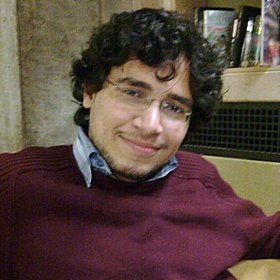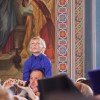Part III
Monophysitism, Then and Now
Exclusive to Pravmir
Edited by Elizabeth J Iskander
 Introduction
Introduction
In the previous part, I discussed the historical origins of the Monophysite movement and how the Council of Chalcedon stopped its march towards a complete take over Christendom. In this article I will demonstrate how Monophysitism was a real ideological movement and how it continues until today in the teachings of the anti-Chalcedonian churches.
Chaos Outside Chalcedon: Different Monophysitisms?
After Chalcedon and the deposition of Dioscorus, Monophysites were fragmented. There was no single rigid Monophysite entity. Monophysite Christology took time to develop its various forms. However, all these forms shared an antipathy towards the Council of Chalcedon and Christ’s consubstantiality with humans in His manhood.
This is the core of Monophysitism; Christ is not consubstantial with us in his manhood. Regardless of the question of the completeness of His humanity, He is not typically like us. This concept is the point of departure for every Monophysite scholar. Later the reader will discover that the deviation between them may lead to considering each others as heretics.
Radical Monophysitism
The earliest stream of Monophysitism is the radical one and it is attributed to Eutychus and Dioscorus. The Antiochian assistant of Dioscorus, Barsumas, said: “if the blood of the Crucified Only Son had been of the same nature as the blood of the sons of Adam, how could it have expiated the sins of the sons of Adam?”[1] A fragment of Dioscorus’ thought is preserved in the “Antirrhetica” of Nicephorus (Spicil. Solesm., IV, 380) which asks: “If the Blood of Christ is not by nature kata_ fu&sin God’s and not a man’s, how does it differ from the blood of goats and bulls and the ashes of a heifer? For this is earthly and corruptible, and the blood of man according to nature is earthly and corruptible. But God forbid that we should say the Blood of Christ is consubstantial with one of those things which are according to nature”.[2] Even in the letters attributed to him by Monophysite historians, Dioscorus refrained from confessing the double consubstantiality.[3]
This type of radical Monophysitism lives on today, as we will see, in the Coptic Church. It is not shared by the Syrians who are loyal to the most important Monophysite figure in history, Severus of Antioch.
Severus of Antioch: Monophysitism with Nestorian Elements
A violent man who led militias and spread horror among his opponents and backed by Emperor Anastasius who embraced Monophysitism, Severus became the patriarch of Antioch around the year 512. He wrote some interesting polemics explaining his rejection of Orthodoxy.
Severus believes that Christ is one composite hypostasis out of two hypostases, not merely two natures. These hypostases contain their own persons. Surprisingly, we find the two discordant Christologies i.e. Nesotrianism and Monophysitism are combined together to give the Severian Christology.[4] V.C. Samuel, the Indian Monophysite scholar, says: “The Divinity and the Humanity, then, combined into one. The moment that divinity came to union in God the Son, the Humanity came to union in an individuated state. As Severus says the two natures which came together in union were hypostases … in uniting humanity to Himself, does God the Word assume it only as an abstract reality, without being in a hypostatic or personal condition? If the humanity of Christ doesn’t have the features which make it a person, can it function in anyway in the incarnation?[5] Saint Maximus the Confessor detected this strange combination and ascribed the Nestorian understanding of the union of natures to Severus.[6]
These are the main streams of Monophysitism. Because of that, Dioscorus and Severus are highly regarded as the greatest teachers in Christianity for Monophysites and that’s why the Coptic liturgy mentions their names before all the patriarchs and saints. The later Monophysite classics contain a mixture of these streams.
In Egypt, there were famous medieval Coptic scholars who wrote in that trend. Ibn al-Makin wrote the most important theological voluminous work in 13th century Egypt. He asserts that Christ’s human nature is not completely like ours, and the reason, which is the same one Dioscorus used to be the point of departure for his Christology, is that His body is united with Divinity and this makes it impossible to think of Christ’s consubstantiality with us in his manhood. According to al-Makin, “Whilst the fathers confessed His complete humanity, they didn’t state that every aspect in our humanity should be in Christ’s or vice versa”.[7] He explains the difference between our nature and His humanity asking how Christ’s human essence Jawhar is like ours while he has a virginal birth, is free from Original Sin, united with Divinity and is incorruptible, while our nature is corruptible and lacks the previously mentioned unique features.[8] He considers that the union made one essence, unlike “the hypostatic union” and, interestingly, he attributes it to the “Melkites”, meaning, the Chalcedonians.[9]
We see a radical Monophysitism sharing the same arguments of Dioscorus and Barsumas against double Consubstantiality. However, we find Ibn al-Makin repeating Severus’ idea of having, “a man Ensan, the temporal Son al-Ibn al-Zamany, who was united to the eternal Son al-Ibn al-Azaly, the Word.”[10]
The same trend of gathering these two streams can be found in most of the Arabic Monophysite classics even before Ibn al-Makin, like the famous works of Sawiris Ibn al-Muqaffa (Severus of Ashmunin).[11]
Current Teaching in the Non-Chalcedonian Communion
The teaching of the different Monophysite bodies didn’t change. They kept the attitude of swinging between these two different Monophysite streams. However, notable developments took place recently. For example, we can find that Armenian scholars do not find any problem with declaring that they accept faith of Chalcedon and that their problem is with the council’s timing.[12] They even go further to declare Severus of Antioch to be a heretic, and that, “the Armenian church doesn’t accept the heresy of Severus Hartaqat Sawiris of Theopaschism (the belief that God can suffer in his very nature).”[13]
However, that’s not the official stance of the Non-Chalcedonian speech. The Coptic Church still publishes the texts and works of its medieval fathers who held unorthodox Christology. Even in its formulae and recent writings, they show a strong hostility to Chalcedon and its Christology.
Anba Gregorius, who is considered to be one of the most accredited Coptic scholars in the 20th century, and the teacher of the patriarch Shenouda, rejects St. Leo’s distinction between the two natures even after acknowledging unity.[14] Moreover, he states clearly that the Coptic Church condemns the Chalcedonian church’s confessing that Christ is a perfect God and perfect Man.[15] Gregorius goes still further by asserting that, “ I before God I reject the term Double Consubstantiality if it means the duality of essences[…] we admit that these essences after unity became one.”[16] Meanwhile, Romanides’ whole argument for supporting the orthodoxy of Copts is their alleged acceptance of the duality of essences, since they distinguish between nature and essence. This doesn’t fit with Gregorius’ own definition here.
Metropolitan Bishoy, the General Co-secretary of the Joint-Committee of the Dialogue, showed a clear rejection of Orthodox Christology.[17] In his paper presented to the 3rd meeting between the Russian Orthodox Church and Oriental Churches in Lebanon, he declared that they refuse considering Chalcedon to be an Ecumenical Council. Furthermore, he tied accepting the acceptance of Chalcedon’s ecumenicity with the acceptance of the Robber Synod of Ephesus in 449 by the Orthodox Church![18]
While he considered that the Orthodox deliberately misunderstood it, Shenouda III, the Patriarch of the Coptic Church, dares to label his Church with the term “Monophysites”, instead of the term Miaphysites.[19] He repeats the same condemnations of Gregorius against confessing Christ as a perfect God and perfect man.[20]
Conclusion
Whilst Monophysitism took different shapes, it survived down centuries in several forms, different speeches and languages. The teachers of the Monophysite church today didn’t give up using the classic forms of monophysitism in the confessions. Unlike the Armenians, the Coptic side showed how much they lack the aptitude to modify their Christology. In the next and last article of the series, I will highlight the implications and impact of Monophysite Christology on the Coptic different doctrines, showing how much it is deviated from the Orthodox theology.
To be continued…















